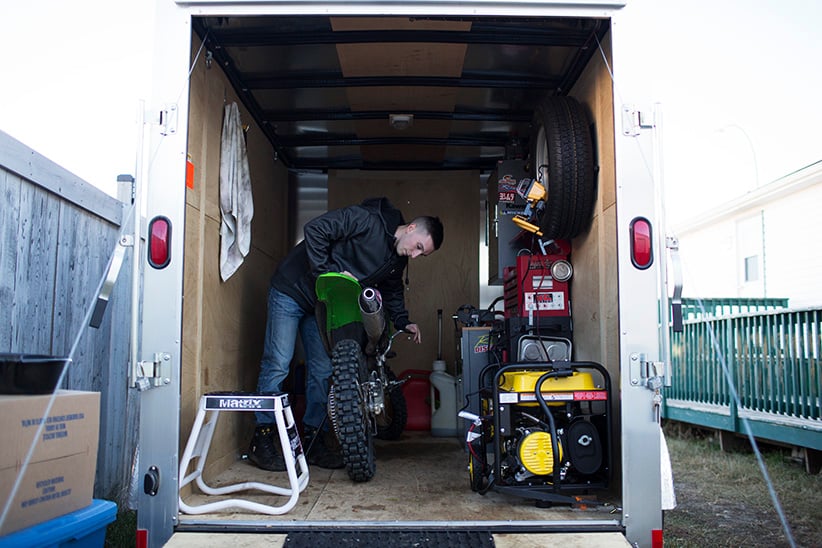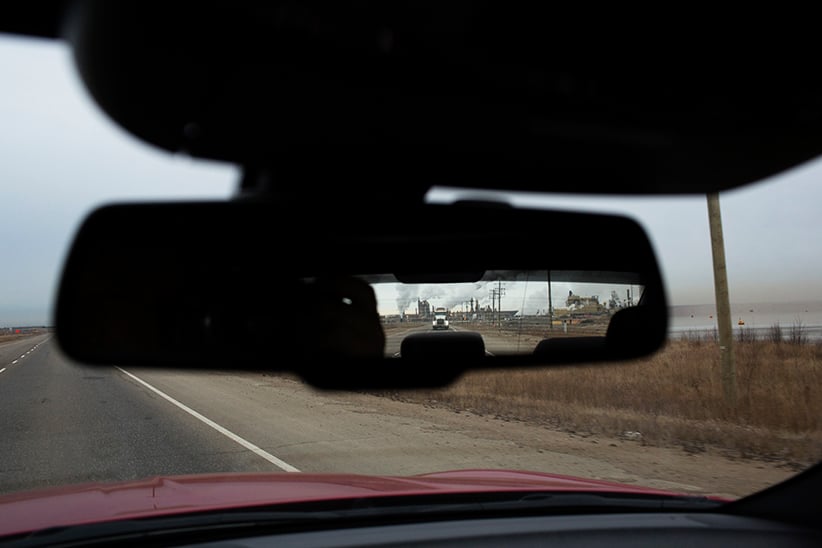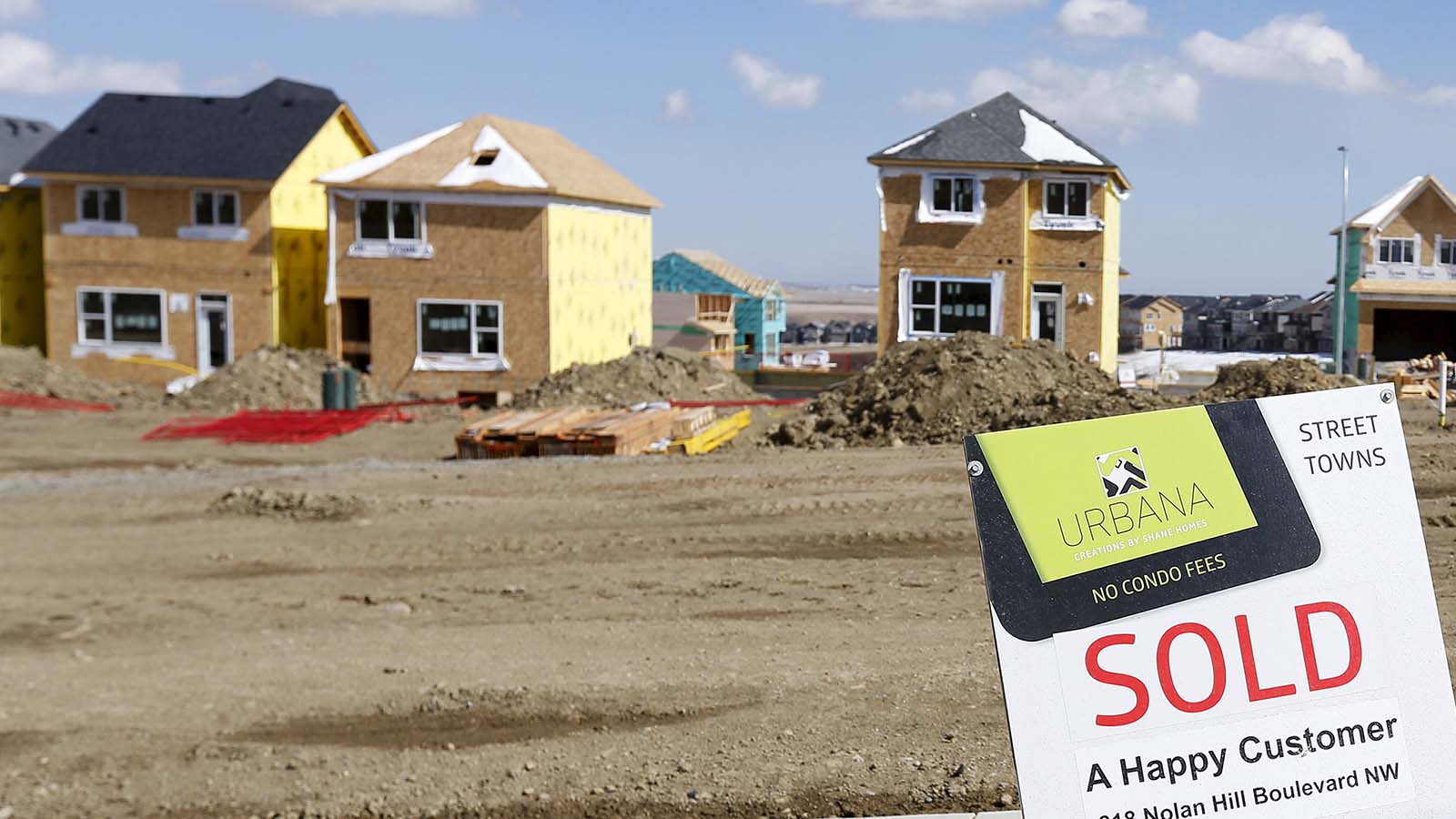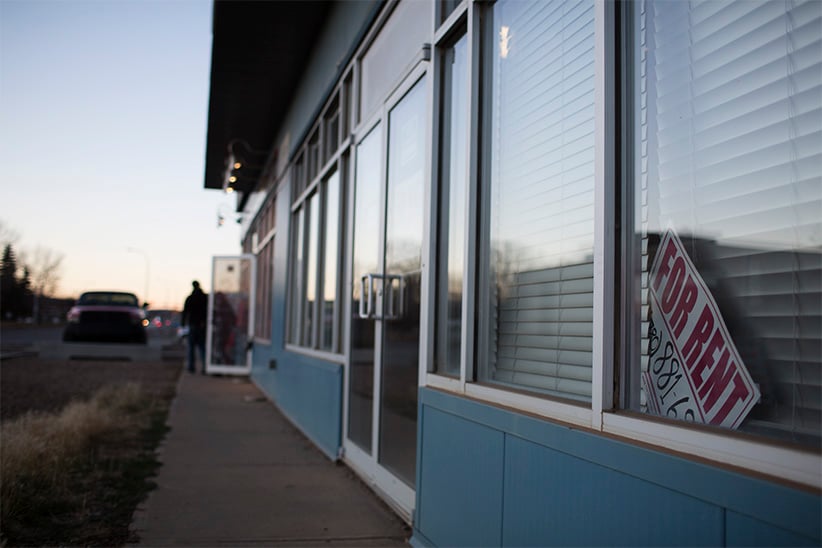The death of the Alberta dream
Large-scale layoffs, empty office towers, falling house prices: Alberta has been gutted by the glut.
Petro-Canada’s Edmonton Refinery and Distribution Centre glows at dusk in Edmonton. (Dan Riedlhuber/Reuters)
Share

Late last year, Brandon MacKay listed his Kawasaki dirt bike for sale on Kijiji, the online classifieds site. It was the only treat the 25-year-old had given himself in three years living in Fort McMurray. The rest he’d spent on supporting and visiting his wife and kids in Pictou County, N.S. But in crafting the ad for the bike—$4,400 or best offer—MacKay did what any sales agent would advise against: he revealed his desperation to sell. “I lost my job and am in need of money for my wife and kids for Christmas.”
MacKay had followed a well-worn path to prosperity for East Coasters: with limited job prospects at home, the engineering technologist flew to Alberta’s oil sands capital and found a job in mechanical sales. It was good money. He bought a 30-acre plot and 2,000-sq.-foot house for his family back east. One day, while he was setting up for a client visit, his branch manager summoned MacKay for what he thought would be a meeting about sales projections for 2016. “Before I could even sit down,” MacKay recalls, “he told me it was my last day.”
Now MacKay is faced with a reality that would have been inconceivable a year ago: he might have to leave Alberta to find a job.
MacKay’s ordeal is just one example of the upheaval many Albertans, new and old, have suffered since oil prices began their long, hard crash. It’s affected everyone from steel-toed rig hands to French-cuffed executives, with layoffs hitting Calgary and Fort Mac, not to mention the many small towns across Alberta that rely heavily on the energy sector.
As this downturn has unfolded, the great oil rout of 2014-15 seemed, at least at first, to be following a similar pattern to other busts. Some big oil sands projects get delayed, rig and well activity shrivels and Employment Insurance rolls spike, leading to knock-on effects: Calgary towers thin out, the real estate market softens, and cuts spread to everything from shops to restaurants. Yet past plunges were reliably followed by a bungee-like snap back in growth, as oil prices regained their upward momentum. It’s a pattern a generation of Albertans has come to expect, after the 1998 Asian financial crisis, the 9/11 terrorism shock and the 2008 financial crisis.
But the broad optimism of early 2015 has gradually given way to dread. This feels more like the awful 1980s, with no swift recovery to come—not in a world glutted by oil, as Saudi Arabia battles to squeeze out higher-cost producers like Russia and the United States. Before Christmas 2014, as prices thudded from above US$100 per barrel to below US$60 for the first time since the Great Recession, oilpatch observers wondered how soon US$80 oil would return. Instead, the OPEC cartel’s decision to keep pumping, and the surprising resilience of U.S. producers, have pushed oil down to below US$40.
Energy companies are preparing for a grim 2016. Analysts predict budgets will get slashed further, and that more energy firms may have to cut staff, having already laid off thousands. Ongoing oil sands construction projects will continue to wind down with little to replace them, hitting both the residential and commercial real estate sectors hard. For instance, in nearly one-sixth of all the office space in downtown Calgary, the fluorescent lights now shine on empty cubicles, and it’s forecast to get worse. Reports of the symptoms pop up almost daily: more insolvencies, more business for moving trucks and repo crews, even a noticeable uptick in suicides. The Calgary Stampede itself has been forced to lay off staff, as its offseason event bookings dried up. In November, the Alberta unemployment rate came within one-tenth of a percentage point of the national average, the closest it’s been since 1989. Those trend lines are expected to cross over next year, making it more clear to Canadian job-seekers that the Alberta dream is in decline.

The rest of the country isn’t immune from those ominous grinding sounds coming from Canada’s longtime economic engine. Canadian GDP dipped into recession territory in the first half of 2015 on the oil shock, and though the country managed a rebound in the third quarter, Alberta’s troubles—as well as slumps in other oil-rich provinces like Saskatchewan and Newfoundland—have left a gaping wound. The energy sector had long driven Canada’s trade surplus, papering over weakness elsewhere while soaking up large numbers of unemployed and underemployed people from regions like the Maritimes and hard-hit southwestern Ontario. Many economists predict a gradual rebound, but nothing head and shoulders above national growth rates, as had been typical for Alberta. “Average growth” is an unfamiliar term in Alberta, and will take some getting used to.
But even average growth seems a ways off, as troubles keep filtering through the province. In Alberta’s southeast, Medicine Hat drew international acclaim in the spring of 2015 after it became the first city in Canada to eliminate homelessness, having pursued an ambitious five-year agenda to put people into subsidized housing within 10 days of them landing in emergency shelters. After so much progress, Medicine Hat’s Salvation Army shelter is back to averaging 17 clients a night, up about one-third since 2014—too many to promptly find them all affordable housing. Local demand for donated clothing and household items also rose by more than a quarter over the last year, says manager Murray Jaster. But donations slumped too, and he had to reduce staff. When he’s out along the Trans-Canada Highway that dissects Medicine Hat, Jaster has noticed more hitchhikers than he’s seen in years—people looking to take the long road home, or perhaps to wherever in Canada the jobs may be. “Man, we’re a have-not province all of a sudden,” Jaster says. “Who can believe it? I can’t.”
To be sure, the oil crash isn’t yet deep or dark enough to have actually lowered Alberta to the status of federal welfare case, qualifying for equalization payments. It still remains a wealthy province, with the highest average weekly income in Canada. “It’s still not that bad relative to the rest of the country,” says University of Calgary economist Trevor Tombe. “I think we were just used to things being so good that we lost a little bit of perspective.”
But, to Jaster’s point, there is much his province used to have that now seems gone. Most noticeable is Alberta’s eroding status as the Promised Land for so many Canadians from other parts of the country. Over the last decade, net interprovincial migration by 18- to 44-year-olds, the key working demographic, swelled Alberta’s population by 200,000, according to a report by a rather envious Business Council of British Columbia. (That province netted fewer than 40,000 over that stretch, while all other provinces were net losers.) The momentum has shifted. While 1,200 more Canadians still moved to the province than left it during the third quarter of 2015, that was the smallest gain since 2010—when the province was recovering from the 2009 oil price collapse—and less than half the average of the last 50 years.

Chris Hickey was a Newfoundland import 14 years ago, and welding had been good to him. Last spring his bosses at the fabrication company where he worked held a picnic. They acknowledged the business was showing signs of slowing, but said they didn’t foresee having to make changes. The next day Hickey was laid off, along with one-third of the day shift.
Where is his next hope for employment? Hickey doesn’t know. When New Brunswick-based Irving Shipbuilding held a job fair in Fort McMurray to lure workers back to a government project at its Halifax shipyards, Hickey applied, but never heard back. “I probably sent out a good 1,000 resumés since, from Newfoundland to B.C. and all the way down to Texas and all over the world,” Hickey says. “I’m pretty much going to take anything I can get.”
Hickey is all too aware his Employment Insurance runs out in April, which meant a lean Christmas and heightened anxiety for his girlfriend and him in 2016. With the province’s EI rolls double what they were a year ago, and legions getting by on severance packages, many unemployed Albertans will hit that wall this year. All told, as a result of job losses and pay cuts, the energy sector now puts $100 million less into Albertans’ pockets every week compared to before the oil crash, according to job and wage numbers crunched by Todd Hirsch, chief economist for ATB Financial. For out-of-province energy workers, that also means less money being sent back to families at home. As more of them return to their provinces of origin, that could contribute to higher unemployment rates and strains on social services there. “Seeing that there’s no real light at the end of the tunnel right now, more [companies] are turning to job cuts,” says Wendy Giuffre, the president of Wendy Ellen, a human resources consultancy. “It seems that there’s another wave right now. I think people were kind of hopeful things were going to pick up sooner, but it’s not looking too promising.”
Statistics Canada’s payroll survey shows Alberta shed 63,500 jobs over the year leading up to October. That doesn’t account for lost potential—the Canadian Association of Petroleum Producers estimates 40,000 jobs that were expected to be created never materialized.
Oil patch companies were already scaling back spending plans before oil’s most recent tumble in December. Scotiabank commodity specialist Patricia Mohr, who adopted a “lower-for-longer” outlook several months ago, recently slashed her already gloomy forecasts by US$5 a barrel. She now warns the price for West Texas Intermediate crude could potentially drop to US$30 a barrel early in 2016, stay below US$45 a barrel for most of the year, and return to $50 by the fourth quarter. “I think even that is fairly optimistic,” she says.

OPEC’s Saudi-led decision to keep pumping crude in order to regain world market share has so far failed to substantially curb production by non-OPEC countries, notably the U.S. shale fields, Mohr says. Global demand has grown, but not nearly enough to soak up the gusher of supply. At the same time Iran is likely to ramp up oil exports following its nuclear deal with Western powers last summer. Iran could add 500,000 more barrels a day “in a market that doesn’t need the additional crude,” Mohr says.
What’s easier to predict is the impact low prices will have on Alberta’s oil sands. While some existing projects can make money at or below $40 a barrel, Mohr says others require prices of around US$55 a barrel to be viable. Most expansions that had already begun have gone ahead, but to protect their balance sheets companies have shelved billions of dollars worth of new projects. “New commitments on brand-new projects will probably wait for a better day,” she says. The supply-demand imbalance should shrink and send prices up by 2017, Mohr says, though she expects a “fairly modest” increase.
It’s no secret that Alberta’s economy is closely linked to the peaks and craters of oil prices—nominal GDP (not adjusted for inflation) swings in tandem with crude prices. It’s why Fort McMurray is like a wounded beast these days. MacKay’s neighbour got laid off this fall. “I watched the bank come and take his truck,” he recalls—it was that or not feed the kids. Home prices in November were 20 per cent below last year’s average, with even townhouses and duplexes losing $100,000 in value. According to reports, a number of people who used to regularly donate to the city’s food bank have become clients.
At a recent oil-well drillers conference, industry veteran Brian Krausert set the tone for his annual industry forecast with a bad joke: the best news today, he told his audience, would be that the caterers didn’t run out of scrambled eggs. The crowd’s silence continued as Krausert bombarded them with grim stats: the group had twice slashed last year’s forecast, and the outlook for 2016 is even lower—57 per cent fewer operating days for oil rigs than in 2014, based on oil prices averaging US$45 per barrel. Rig utilization levels will be the lowest since Krausert started tracking them in 1977. “It’s like I told them ‘You’re going to go get your head lopped off,’ ” Krausert, CEO of Beaver Drilling, recalls.

What happens in the oil fields directly affects one of Canada’s largest business cores. Elevator trips to Beaver’s small ninth-floor Calgary office have gotten lonelier. Nearly one-third of the office space in the 32-storey highrise is listed for lease or sublease. The asking rate to rent downtown Calgary’s “Class A” office space is down nearly 42 per cent from last year, the result of “a complete lack of demand,” according to a report by real estate advisers Jones Lang Lasalle. The market is awash in subleases, as companies compete with landlords for the few interested tenants. “Initially it was mid-sized to large companies shedding excess space—space set aside for their future expansion,” says Mike Gigliuk, a vice-president at commercial real estate firm Newmark Knight Frank Devencore. “The next wave was companies of all sizes downsizing staff and trying to shed the newly vacant space.”
CBRE, another real estate firm, estimates a 16.3 per cent commercial vacancy rate, the highest in nearly a quarter-century. It forecasts 18 per cent next year. Already, the vacant square footage in Calgary’s core is double that of all the office space in Saskatoon.
The hollowing out of Calgary offices has decimated the corporate lunch crowd. Regulars who would come to Jalapeno’s Mexican Grill three times a week now visit once, or not at all, owner Doug Hernandez says. “We’re not making any money; we’re just floating right now,” he says. “The problem would be when I’m not wearing my lifejacket anymore. Then I’d drown.” Some Calgary businesses have cheekily played up the downturn: the Barcelona Tavern offers 20 per cent off wine bottles until oil returns to $70, while the Ironwood Stage hosted a “Rocking the Recession” show. The cover charge: $20 “if you’re hangin’ in there” or free “if you’re really hurtin’.”
Some Albertans are already feeling the hurt in the housing market. Real estate sales in Calgary have slowed for 13 straight months, especially among million-dollar homes, and in recent months prices began to fall. The year-over-year benchmark price in November had dropped two per cent. Open houses have been full, but sellers long for last year’s higher prices while buyers want next year’s price plunge today, real estate agent Donna Rooney says. Still, she and partner Gary Cronin believe the housing downturn isn’t yet as bad as previous ones. “There’s not as much distress selling as there has been in previous cycles, partially because of the interest rates, partially because our city has become more affluent and people have more savings than in previous cycles,” Cronin says.

Cheap and easy credit is helping minimize the bleeding for Alberta’s car and truck dealerships. Despite a 20 per cent sales drop at Ed Tercier’s GM dealership in a northeast Alberta town, he says: “We’re still profitable and hope it continues. It isn’t like 1981 where they put up a sign: ‘Can the last one in Bonnyville turn the lights out?’ ” Those dark years of the 1980s came with double-digit interest rates. In contrast, Calgary commuter trains recently boasted ads from upstart lender Cowboy Auto Credit, offering guaranteed loan approval: “Yippee car yay!”
And borrow Albertans have. The average personal debt load (excluding mortgages) sat at $27,490 in September, nearly $4,000 higher than the next-highest province, Saskatchewan, according to Equifax. While more Canadians are paying their bills on time than they have in years, the three-month delinquency rate in Alberta shot up by 13.4 per cent in a year, the credit-monitoring firm reported.
Newly tightened federal mortgage rules designed to cool down markets in Vancouver and Toronto will hit highly leveraged Calgary’s home-buyers harder than in any other major city, a CIBC economist recently wrote. The longer the slump lasts, the more the pain will spread, too. In November, Evan Siddall, the chief executive of Canada Mortgage and Housing Corp., revealed the results of a stress test his federal agency had run: If oil prices stay at $35 a barrel for five years, the national unemployment rate might reach 12.2 per cent and national house prices could collapse by 26 per cent. That was a worst-case scenario, but regardless: CMHC considers the price of oil to be “the most significant domestic risk” to growth in Canada.
The realization is setting in that this downturn could last much longer than first thought. But as Albertans grapple with low oil, another factor dominates the provincial psyche. “The uncertainty is a bit stronger than in the past, of when the turnaround will come,” says Giuffre, the HR consultant. “It’s not pure economics. There’s a lot of politics involved.”

Politics and oil crashes are a potent mix in Alberta. As in the 1980s when that other Trudeau launched the detested National Energy Program, many are watching this Trudeau’s climate initiatives with suspicion. Yet even Fortress Alberta has suffered breaches, with last spring’s surprise election of Rachel Notley’s NDP. It’s a poorly kept secret that Jim Prentice, the 43-year Tory dynasty’s final premier, called May’s election one year early because he feared the economy would continue to worsen. As scorn and blame rain down on Notley for private sector layoffs, she has continually stressed that her government does not control global oil prices. But critics have also targeted her government for decisions it did control: hiking corporate taxes, ordering a review of energy royalties, and unveiling a massive climate change plan that will shutter coal mines and power plants and impose an economy-wide carbon tax. “There are clear signals from the government they’re going to continue destabilizing the investment sector here,” says Brian Jean, leader of the Wildrose opposition.
Obviously that’s not how the provincial NDP sees it. Last fall, Notley named a trusted lieutenant as her new economic development and trade minister to lead recovery efforts. “We do not want to make it worse. We want to work with industry to help support it,” says Deron Bilous. The province has sped up infrastructure spending, budgeted for a modest job creation subsidy, directed more Crown corporation investment and lending to Alberta businesses, and hopes that creating a greener power grid will boost jobs. But Bilous says there are no easy fixes as he meets with industry to better grasp the issue, including a November sit-down with the Petroleum Services Association of Canada. “Everyone was thrilled we were listening,” Bilous says. “We’re taking notes. We’re working with them and want to find solutions.”
Janine Snortland, who attended the meeting, wasn’t thrilled. Her oil field hauling firm east of Calgary employed 22 before the crash, and was down to eight in November. “We can do anything and everything with our trucks, but our specialty is rig moving, and there are no rigs to move.” At the meeting, she expressed doubt that Bilous could promote her sector when the NDP was often “the first one to throw Alberta oil and gas under the bus.” At least he was receptive, Snortland recalls. “He was a nice enough man, but you know what? I’m frustrated.” She’s inclined to return to more conservative Saskatchewan, which she first left two decades ago.

As bad as last year was for Alberta, things will likely get worse before they get better, says Hirsch, the ATB economist. He expects lower retail spending, continued layoffs and declining consumer confidence, all of which will be a drag on the economy. “This recession, compared to ’09, is sort of like being hit with a blunt object. It’s not as painful, but it’s going to linger longer,” he says. Bonuses and salaries “unhinged from reality” will float earthward. “All of this has to unravel. It’s painful, and I don’t want to make it sound like this is good, but in a way it’s healthy—like a high fever and you’ve got the flu.”
The question remains for the rest of Canada: how contagious is that flu? While governments and energy groups long touted the pan-Canadian benefits of the oil sands, most manufacturing and services companies directly serving the sector are concentrated in Alberta. There are exceptions. For instance, Tenaris Algoma Tubes, one of the largest employers in Sault Ste. Marie, Ont., has had four rounds of temporary layoffs since the oil crash bruised demand for its steel products out west. But aided by the lower loonie, those in the manufacturing sector are optimistic the pain will be contained. “It’s a weight on Ontario. It’s not sinking the ship,” says Mike Holden, economist for the Canadian Manufacturers and Exporters trade group. Even so, the sector is struggling. One gauge of manufacturing health, the RBC Canadian Manufacturing Purchasing Managers’ Index, fell to its lowest level in five years in December. According to the report, firms said subdued business confidence was leading them to scale back on spending and put off new projects. Given the widespread uncertainty about the future of oil prices, and its effect on the broader Canadian economy, this fear of the unknown has the potential to do more damage than any direct links between Alberta’s oil patch and the rest of the country.
Alberta’s options are limited. The NDP’s talk of diversifying the economy is easier said than done. Consider two sectors that enjoyed a strong 2015: agriculture and tourism. Combined they account for just 3.5 per cent of Alberta’s GDP. Oil and gas makes up 25 per cent, with far higher wages. Even the NDP’s Bilous admits “diversification is probably more of a medium to long play.”
Which leaves a province of four million people with little to do but wait for a recovery of crude prices to rescue its employment prospects, government coffers, real estate markets and so much else. For shell-shocked Albertans, hope has become a commodity in short supply, and they’ll hang on to whatever they can get.
—with Chris Sorensen